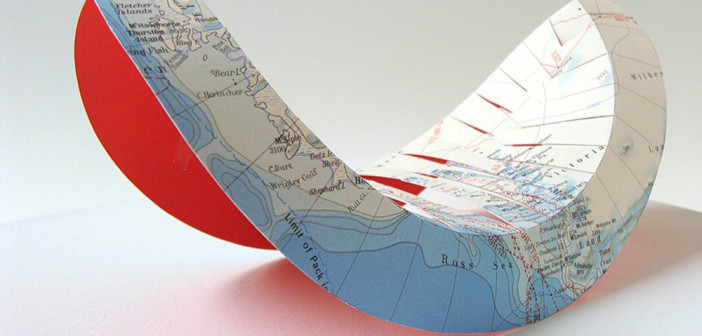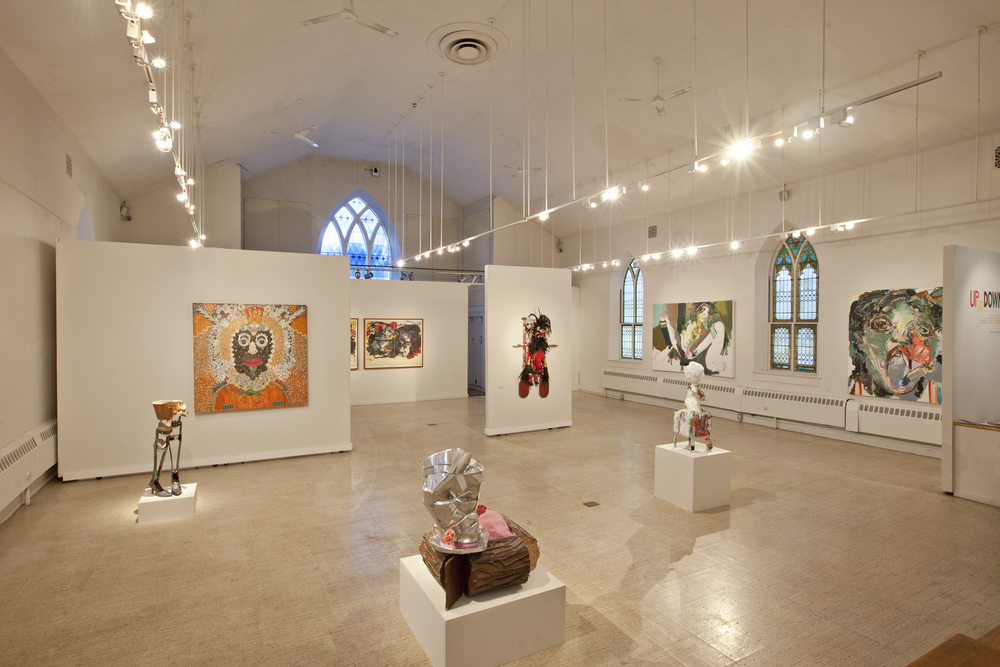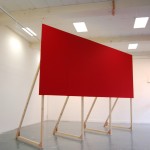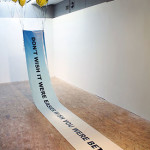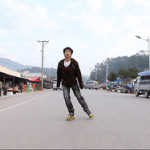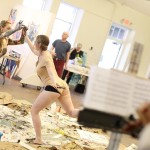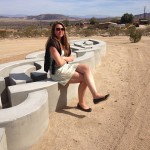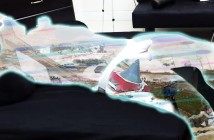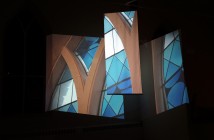"Boston Common" highlights the people and organizations that shape Boston and New England's cultural sector by going straight to the source to find out who they are, what they are doing, and how and why they do it. We hope that the interview series will champion some of the exemplary work being done, shed light on neglected issues facing our arts scene and community, build connections among individuals and organizations, and expand the networks on which we rely. In our newest installment, we talk to the New Art Center's Exhibitions Director Kathleen Smith Redman.
BRS Tell us about the New Art Center. What's its history, mission and focus, how does it differ from other organizations of its kind, and how does it operate?
Kathleen Smith Redman The New Art Center was founded in 1977 as a community art center for Newton, providing art instruction for adults and children. The mission is "to support the development of visual artists and cultivate a community that appreciates art." In 1993 volunteers at the Center initiated an ambitious exhibition program soliciting proposals for exhibitions from independent curators. Over time this has developed into our Curatorial Opportunity Program (COP), which just announced our 2014-15 season: four exhibitions drawn from 60 proposals submitted by curators from 17 states.
The New Art Center occupies a unique position as a conduit between a community and the international art world. Through the COP, our artist residency program and the quality of the NAC’s reputation in the art world, we have developed a continuous spectrum of programming designed to engage people at all levels of experience, from the youngest child to artists and aficionados with years of experience.
The COP increases access to innovating contemporary artists and curators through a community based arts model. Our pedagogical position is non-academic and non-traditional. We promote a method of curatorial education that highlights learning collaboratively by doing. This approach runs through the studios and the galleries. Shared authority can be a risky endeavor but I think it’s a crucial one for any independent and alternative art space wishing to grow the contemporary field and its audience base.
The New Art Center is ultimately dedicated to the proposition that art is a birthright of humanity, and that all human beings should have opportunities to engage with the experience of art in satisfying ways.
BRS What about your specific role at the New Art Center? What did you do before you joined it, and how that work equip you for what you do now?
KSR I direct the exhibitions program, which investigates the presentation and reception of art made today in a sort of "laboratory". The program is comprised of four main areas, the interaction of which strives to connect a local, grassroots art community with the larger contemporary and global art world: the Curatorial Opportunity Program, our new Artist in Residence program, the Holzwasser Gallery teaching gallery and a partner exhibition program that produces shows such as the Mass Cultural Council’s Fellows and Finalists Photography Exhibition.
I endeavor to create platforms for artists and curators in whom I believe. The COP partners with new guest curators, artist curators or curatorial teams every season. My core guiding principles are collaboration, risk taking, shared authority and flexibility. Conversation is key and I love developing projects, exhibitions and residencies that reflect exchange.
I received a BA from Williams College where I studied art history and practice and an MA from Tufts University in the history of art. I worked at museums and galleries in New York City in between, and I independently curated as well. I was an Adjunct Professor around the Boston area after graduate school, and I continued to work on curatorial projects. I have found that pushing back against academia and the status quo is just as important as immersing oneself in it. Teaching at the university level showed me how important and how problematic learning limited to a classroom can be. My experiences studying and teaching, administering programs, practicing public art and independently curating have equipped me to lead, and has led me to, the New Art Center’s exhibitions program. I often embarked upon or developed my experiences together with other artists, educators, students, gallerists and scholars--perhaps this is the best preparation for what I do now.
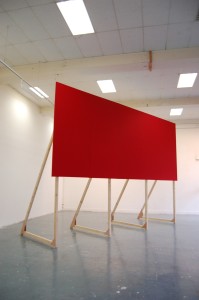
Frédéric Sanchez
For My People, 2007
Acrylic on canvas, wood, 255x600x211cm
Image courtesy of the artist
BRS It looks like the New Art Center has four great exhibitions lined up for 2014 - 2015. Tell us a little about them and how you settled on this particular grouping of shows for the year.
KSR The four Curatorial Opportunity Program exhibitions came through our Open Call. The curators of all selected shows inspired us and our Advisory Panel with their bold and well-presented visions. The season strikes a dynamic balance between the local and the global.
Opening the season, Far from Indochine is curated by Chương-Đài Võ, an independent curator and writer based in Southern California. It features LA based artist Dewey Ambrosino, Boston based artists Patty Chang and David Kelley and French born and Saigon based artist Frédéric Sanchez. The 40th anniversary of the Vietnam War's end will be in 2015. This exhibition presents three contemporary projects about Cambodia, Laos and Vietnam that engage with the myths and ideas that formed the backdrop of the war.
Next up is I Want to Smell Your Hair. It is co-curated by Robert Chamberlin, Laura Beth Reese and Molly Segal, an artist collective and new curatorial team. In addition to the work of Chamberlin, Reese and Segal, they have included work by Chun Hua Catherine Dong, Amy Flaherty and J.R. Uretsky in a show that explores the ways artists create a sense of intimacy between themselves, their subjects and their audiences.
Opening the winter term is Boston and New York based emerging curator Michael Gaughran’s project The Power of Negative Thinking. It features the work of six artists: Stephen St. Francis Decky, Bradley Tsalyuk and Corey Dunlap, Anthony Montouri, Alicia Riccio, Kirk Amaral Snow and Randy Stevens. A satirical response to the post-modern notion that happiness is a commodity we can achieve permanently, the exhibition embraces the creative possibilities of pessimism in both vibrant and subversive ways.
Excavations closes the COP season. Curated by art historian Adrienne Jacobson, the interdisciplinary exhibition examines the physical and metaphorical process of excavation in the works of artists who cut away materials and uncover memories. Mining the disciplines of history and archeology, it features several regionally known and internationally active mid-career artists: Laura Evans, Candice Ivy, Ken Landauer, Shannon Rankin, Jill Slosburg-Ackerman and August Ventimiglia.
BRS Since the New Art Center operates on an Open Call exhibition proposal model, what can you share with us about making that approach successful? What open call exhibition models and non-profit exhibition spaces have you looked to for inspiration or possibly counsel?
KSR The Open Call exhibition proposal model is a thrill. It is uniquely suited to choreographing the kind of exciting discourse that we’ll showcase next season. I don’t think one individual could have devised the series!
In order to succeed, one needs to love ideas and the people that hatch them. I connect with each new curatorial partner and their artists in a way that’s unique. We allow curators and artists to be our guide, and earning their trust allows us to in turn be theirs. It is democratic, and refreshingly objective, to capture the pulse of the people and cede authority to those with the best ideas. Both Dan Elias, the New Art Center’s new Executive Director, and I are fueled daily by the program and its mission--it drew us both here. A passion for teamwork and learning in a non-hierarchical and non-traditional setting is important for a contemporary art organization to thrive. I learn and grow tremendously with each partnership, and our audience grows as well.
I have been inspired by open call models at a variety of organizations, including NurtureArt in Brooklyn, the Wassaic Project in Wassaic, NY and apexart in New York City. But what I think sets us apart is our interest in providing individualized feedback and constructive criticism to each curator whose proposal was not accepted. The dialogue always continues.
BRS Please share some of your projects and plans for the future of the New Art Center.
KSR I plan to develop our Curatorial Opportunity Program's workshops, which might soon span several weeks or immerse participants in a weekend of dialogue and production. I look to Independent Curators International in New York City for new ideas. Its curatorial intensives, which happen around the world, are incredible.
Our residency program will grow and become a more prominent piece of our mission. We will host Far from Indochine’s French born Frédéric Sanchez as our resident artist for eight weeks, beginning in late August. He will come to us from France and leave us for Saigon, which exemplifies the importance of global exchange in his practice, and increasingly for ours. He will work on a new, site specific project and present talks and programs to our community and the public during his residency.
Dan Elias, with whom I closely collaborate, has plans that are important to understanding why exhibitions will matter more for the organization in the future.
"Over time the New Art Center will expand its offerings in a variety of ways. We will develop programs for people who wish to engage art in ways other than making; we will develop programs to explore the role of creativity and art in the workplace, and how to manage creative processes; we will develop programs that provide thoughtful discussion of the role of art in society. Finally, we will sustain our building, our staff and our institutional life, through a process of planning, endowment building and renovation, so that the influence of artistic expression, thought and experience can take a central role in our community."
BRS What are the challenges you face, and how are you working to address them? What's your biggest need right now?
KSR At first I thought a major challenge was local talent leaving for New York, LA and Chicago, just to name a few places. But I realize that the potential to grow our network globally can be a major benefit for Boston. So the challenge is not talent leaving but rather them leaving without thinking that remaining connected to Boston, its people and its organizations is worthwhile. Boston’s relevance on a global scene is crucial to its sustainability locally and our Open Call can facilitate connection around the globe.
One of our biggest needs is funding for our risk-taking programs like the COP. We are convinced that funding will follow if we pair the local with global. I am working to promote the call program farther and wider through partnerships with more internationally focused platforms while always searching for the best and the brightest in our backyard.
BRS What advice do you have for someone looking to follow in your footsteps? What do you wish you knew when you first started out?
KSR Dive in, take risks and be open to giving up things in order to gain new horizons. Art is a social act so surround yourself by people who are smarter, more talented and more passionate than you--we keep each other going. Some of the best advice I ever received was from an artist and educator in honor of a mutual friend. It came at what could have been a very hopeless time: be brave. Always be brave. I think about that often.
Everything you’ve learned is always with you somehow so don’t worry if you think you’ve wasted time--you have not. I realize that my learning has been fueled by saying yes to all kinds of opportunities, and I have believed in the process. But, every yes is a powerful choice. Choice is all we have, curators especially, so use it wisely!
BRS Name one challenge that the Boston cultural sector faces, and how you’d suggest fixing it.
KSR Dan and I agree that challenges abound in Boston. But we also agree that complaining won’t help. The low level of philanthropic inclination and the low level of municipal investment in the arts and culture, perhaps because we are surrounded by many other strong and prestigious sectors, is a huge challenge. These issues, however, are also opportunities for cultivation and harvest. That relatively few people support the arts at a transformational level means that there are those out there who have never considered it, and might be the mega-funders of the future. It’s up to our cultural organizations and leadership to develop creative, fun, attractive and exciting experiences that energize the cultural sphere.
BRS Tell us about one cultural event/exhibition or organization/individual (other than your own) that has exceeded your expectations recently. What work are they doing, and why is it important?
KSR This is a difficult question because there are many. My expectations are constantly exceeded. Because of all my talk about connecting the local and the global, I will point to some recent projects that exemplify each.
The Carpenter Center for the Visual Arts (CCVA) joined Creative Time and Independent Curators International (ICI) to present a customized iteration of Living as Form (The Nomadic Version). It is an ingenious proposal-- provide a format into which localities can insert their recent projects and extend the dialogue begun by more global and historical projects.
The ICA/ Boston’s Anna Stothart and John Andress collaborated to develop a special live performance with Icelandic artist Ragnar Kjartenson, replete with local singers and pianists from the Boston Conservatory, in conjunction with the show Ragnar Kjartansson: Song. This project became the theme of a New Art Center Curator Workshop, where together with Stothart and Andress we discussed performance and related programming in curatorial practice today.
Artist and educator Marlon Forrester’s recent exhibition at Medicine Wheel titled Marlon Forrester: Preparing for Flight. Its opening night was expansive for me. Forrester is an African American Master Artist-in-Resident at Northeastern University's famed AAMARP Program and he is the lead teacher of City Studio, both programs that the greater Boston art community and beyond need to know about!
Finally, Lexi Lee Sullivan’s show BRINK v1 at the Mills Gallery and its related artist panel, which brought together four artists and one artists’ collaborative to explore ideas of itinerancy in contemporary photographic practices. It was the first in a series of exhibitions devised by Associate Director of Visual Arts Randi Hopkins that are dedicated to emerging art in the Northeast. The Mills Gallery, the only mid-sized, alternative and non-profit contemporary art space in Boston, is innovating again!
- Shannon Rankin Adaptation, 2011 Arctic map, acrylic, paper, 10″x10″x10″ Image courtesy of the artist
- Frédéric Sanchez For My People, 2007 Acrylic on canvas, wood, 255x600x211cm Image courtesy of the artist
- Bradley Tsalyuk and Corey Dunlap, Don’t Wish it Were Easier Wish You Were Better, 2013 Custom printed banner, mylar balloons, stone tiles, 20’x2′ Image courtesy of the artists
- Patty Chang and David Kelley Route 3, 2011 3-channel synchronized HD video projection, 27:21 min Image courtesy of the artists
- Upsodown, curated by AJ Liberto and Kate True, a Curatorial Opportunity Program exhibition at the New Art Center. Photo by Peter Vanderwarker.
- Human Form (Transposed), a painting and performance intervention in the New Art Center studios. Photo by Steven Lewis.
- Kathleen Smith Redman with Elizabeth Devlin, curator of Pedigree, a Curatorial Opportunity Program exhibition. Photo by Sarah Pollman.
- Kathleen Smith Redman. Photo by Bernard Leibov, at his BoxoProjects Residency in Joshua Tree, CA.
The New Art Center is located at 61 Washington Park, Newtonville, MA 02460
www.newartcenter.org

